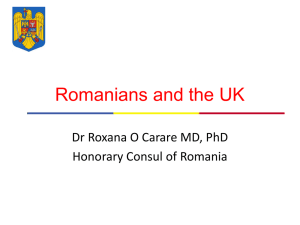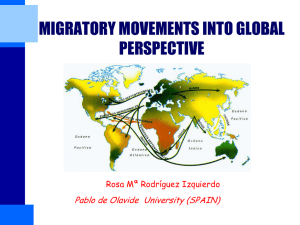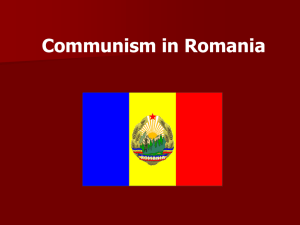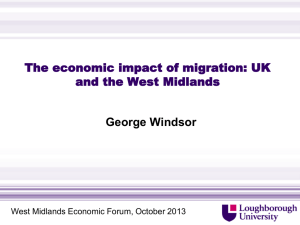An examination of emigration (outflow) of young and
advertisement
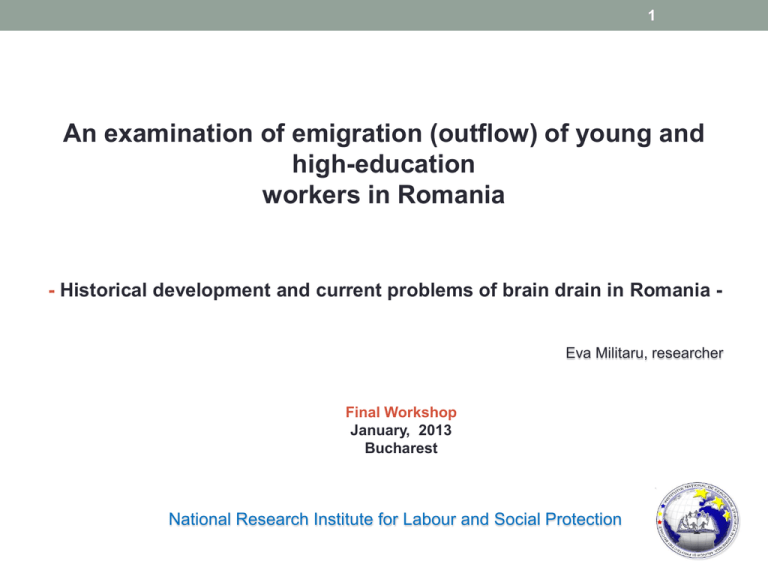
1 An examination of emigration (outflow) of young and high-education workers in Romania - Historical development and current problems of brain drain in Romania Eva Militaru, researcher Final Workshop January, 2013 Bucharest National Research Institute for Labour and Social Protection 2 Outline: • Size of migration • Migrants profile • Brain drain • Student migration • Return migration 3 Size of migration • Romania is among the top emigration countries in the world, by the number of migrant stocks, being ranked the 18th. • World Bank estimates for the migrant stocks of Romanians for the year 2010 indicate an impressive figure of 2.769,4 thousand Romanian nationals living abroad. • This accounts for approx. 13% of the Romanian population. 4 Migration for employment abroad - rate at 1000 inhabitants, 1990-2006 Source: Temporary living abroad: Economic migration of Romanians: 1990-2006, Open Society Foundation, 2006 5 • Except for Italy and Spain, the migrant stocks by country have remained rather steady along the eleven year span. • Boosting after 2002 with Schengen visa removal and intensifying after Romania’s EU accession, the migration flows from Romania to Italy and Spain gathered almost 8% of the population of Romania. • Encouraged by the cultural bonds, the ease to learn the languages, Romanian migrants became extremely attracted by the prospect of living and working in these countries and started to migrate firstly on individual basis and consequently, stimulated by the least difficult integration, they have created networks that further on made that migration from Romania towards these countries to become a mass phenomenon. • Favorite destinations for Romanian migrants before 1990 and during early post-communist period, Hungary, Germany, Israel and United States were no longer targets. 6 Migrant profile • Married men aged between 34 and 50 years from urban areas where the pioneers (1990-1995), women and rural areas began to enroll into the flows later on. • Young people aged between 15 and 29 years old were the main actors after the Schengen visa removal (after 2002), thus accounting for 48% of the migrants. • Balanced gender structure,12% of the migrants were women during early stages, and reached 44% during recent stages (Sandu, 2006). • During early stages (also before 1990) migration was based on ethnicity, more than 60% of the migrants were of other nationalities than Romanians: Germans, Hungarians and Jews. • In 2009, Romanian nationals represented the mass of the migrants, as they counted for more than 98% of the total migration (NIS data, migration with permanent change of residency). • Family reunification accelerated the heterogenization of the Romanian migrant population, which now comes to comprise all population segments. 7 Brain drain • Nowadays, the fourth stage of Romanian migration is taking place (Ulrich et al., 2011), it refers to the migration of highly educated professionals, circumscribed to the brain drain phenomena, which has been enhanced by the economic and financial crisis since 2008. • Migration of highly educated people from Romania is not a new issue, but goes back to the times of the communist regime. • Before 1990, particularly United States, Canada and Australia had selective immigration policies which were in favor of high skilled workers. • Through agreements concluded with USA, Israel, Hungary and Germany, these countries became the destination of nearly 300 thous. Romanians (Gheorghiu, 1996 apud. Prelipceanu, 2008) and most of them with tertiary education. • After 1990, along with low or medium educated migrants, well-trained specialists have left the country. 8 Distribution of migrants by educational level, % Educational attainment primary secondary vocational/ high school university 1990-1995 3 2 78 17 1996-2001 3 8 79 9 2002-2006 Total 1 16 77 7 2 13 77 9 Source: Temporary living abroad: Economic migration of Romanians: 1990-2006, Open Society Foundation, 2006 • between 1990 and 1995, 17% of the migrants held a university degree • their share has decreased to 7% after 2002 • but, the flows between the first and the third migration stage have almost tripled • actually the absolute number of migrants with tertiary education has been constantly increasing. 9 Migration rates by gender and educational level, 2000, % migration rates (%) level of education primary secondary tertiary Male Female Total 7,0% 1,4% 11,1% 2,7% 1,8% 11,4% 3,8% 1,6% 11,3% Source: F. Docquier, A. Marfouk, B.L. Lowell (2007) • Migration rates are calculated as the proportion of the tertiary educated who migrate in the total tertiary educated population in the source country, and similarly for the breakdown by gender. • A slightly higher proportion of tertiary educated women have left the country until 2000, and it is worth mentioning that, at that time, the proportion of tertiary educated women in the total employed women in Romania was at 8,5% (source: National Institute of Statistics, 2001). • Other estimations based on DIOC-E database, indicate the proportion of tertiary-educated of native-born population in origin country for Romania at 12,08% (Dumont at. al, 2010). • According to the same estimations, the proportion of tertiary-educated among the overall stock of migrants accounts for almost one quarter (24,1%). 10 Migration of IT professionals • Migration of IT specialists has most frequently occurred during mid-1990s, when ranges of university graduates left the country, benefiting from scholarships from prestigious universities in the USA, Canada, Ireland or United Kingdom. • Encouraged by the prospect of an adequate job with a very high level of earnings associated with the lack of the Romanian labor market to offer them something similar. • Thanks to the rapid development of the local IT sector, Romania being one of the fastest-growing IT markets in Central and Eastern Europe, the mass migration of IT specialist has been seriously slowed down. • The Romanian labor market is now absorbing approx. 4,7 times more IT specialists than compared to 2000 (Source: National Institute of Statistics, 2011). • Developments favored by the legislative framework, especially in the fiscal area. 11 Migration of physicians • On the contrary, a continuously increasing number of Romanian physicians are pushed towards migration. • The main motives behind are to be found in the low wages and often improper working environment or lack of resources for adequate health services. • The medical brain drain from Romania accounted for 3.913 professionals in 2004, meaning a rate of 8,7% of the physicians trained in the country (Bhargava, Docquier, and Moullan, 2010). • The medical brain drain has intensified after Romania’s accession to the European Union (2007). 12 • Since 2007, 10.000 Romanian medics have migrated for work abroad. • During 2010 and 2011 a total of 5.620 physicians have requested professional certificates in order to apply for a job outside the country (Source: Colegiul Medicilor din Romania). • 52.000 physicians practice their occupation in Romania (Source: National Institute of Statistics, 2011). • Top destination countries for the medical brain drain: United Kingdom, France, Germany, Ireland, etc. • It is worrisome that Romania is actually facing a shortage of health care staff, and, as the issue of scarce resources is prevailing, policies seem to be inefficient in order to stop, or at least slower down the medical brain drain. 13 Student migration • The migration of students is a developing trend that influences future highly skilled migration (IOM, World Migration Report, 2010). • Link between student flows in foreign countries and later migration to these countries (Dreher and Poutvara, 2005). • The ratio of students with Romanian nationality enrolled abroad to resident students with Romanian nationality is 3% (source: UNESCO and EUROSTAT, 2002-2003) and accounts for approximately 19 thou. students. According to other sources (i.e. Liga Studentilor Romani in Strainatate) the size of international mobility of Romanian students outnumbers 50 thou. persons (2012). • The results of a survey among Romanian students who are enrolled in tertiary education abroad show that their return intentions to the home country after graduation are present for approximately one quarter of them and 38% are undecided (Source: Liga Studentilor Romani in Strainatate, 2011, sample size: 752 students) 14 Return migration The Romanian government has established a set of measures aimed at encouraging return migration (2008). (1) Improvement of the information base concerning Romanian migrants who work abroad. The measure aimed at the collection of relevant administrative and survey data and was intended to lead to a database that shall be periodically updated and which shall contain data on the number and main socio-demographic characteristics of Romanian migrants, destination countries, economic activity and occupation of migrants in the host country, working conditions and motives lying behind migration. 15 (2) Public information campaigns regarding employment opportunities in Romania and employment mediation for the Romanian migrants in order to help them to find a job in Romania. The Ministry of Labour and the National Employment Agency have organized, during 2008, employment fairs in the regions with large Romanian communities in Spain and Italy. The number of participants was rather low and the outcomes were far from what was expected. 16 (3) Encouraging return migration through a range of facilities for migrants and their families, such as: • consultancy and assistance for entrepreneurship startup schemes (including assistance in accessing the European Social Fund), • participation in training programs, • job search support for the spouse of the migrant, • psychological counseling for the children, • recognition of professional certificates and/ or informal competencies acquired abroad. As the level of migrant remittances was at peek at that time, the Romanian government tried to find ways that these remittances to be invested in businesses (especially development of economic activities in the rural areas) by facilitating the access to credits for micro enterprises. 17 Findings of studies Romanian migrants on return intentions of • Returning to Romania is a family decision (INCSMPS, 2011, MEDIT project) and a long term project (Soros Foundation Romania, 2009, Romanian Communities in Spain). • The return intentions are observed in the case of migrants with a bad health condition, but also of those who foresee a positive future for the labor market in Romania (SFR, 2009). • Migrants who are confident in finding a job in Romania, are more likely to have return intentions (INCSMPS, MEDIT, 2011).
